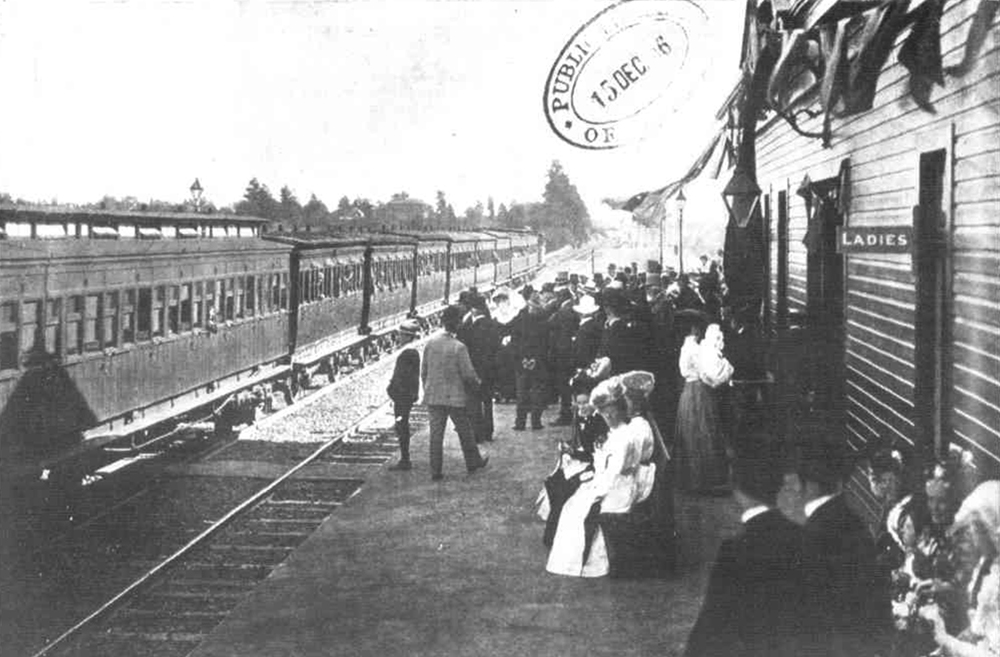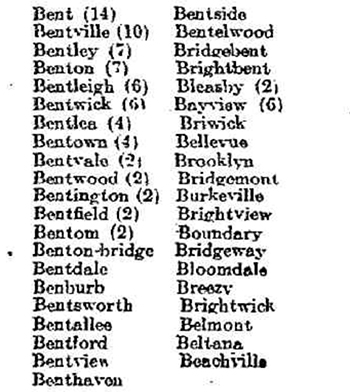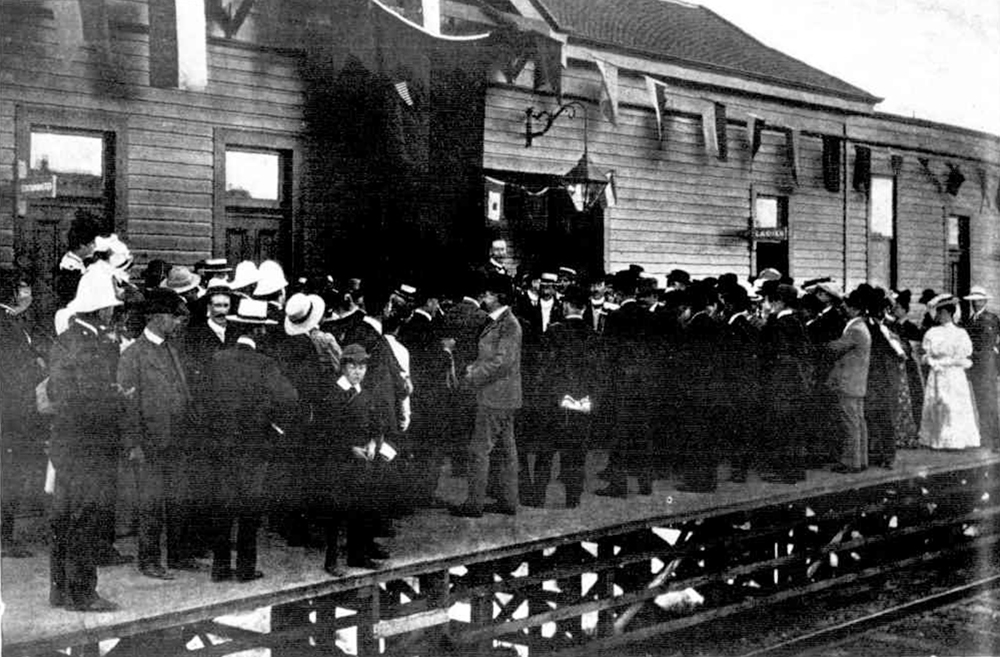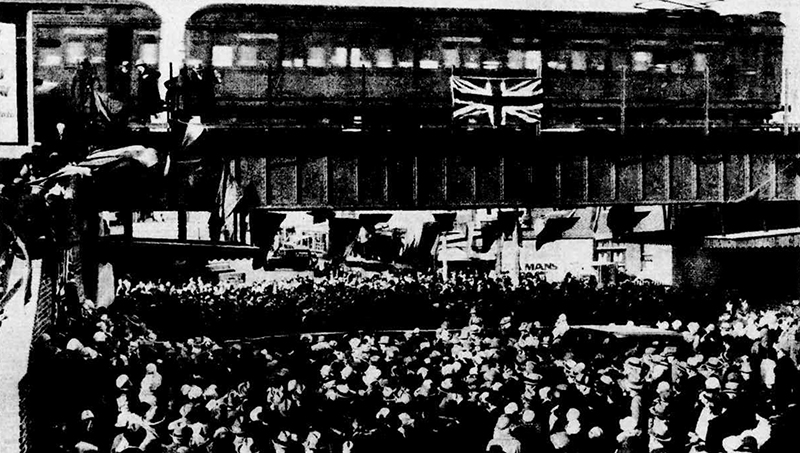The Cinderella of stations
As building work got underway on Gardenvale in 1906, the Brighton Southern Cross hailed it as “the Cinderella of the Brighton stations” – long denied, but now at last allowed to come to the ball.
If the story could be said to have a Fairy Godmother, then it was the people of Brighton and Caulfield, who had campaigned hard for the station’s construction, raised the majority of the funds needed to build it, and even had their say on its naming. From start to finish, Gardenvale station was a community effort.
 Opening of Gardenvale Station, 4 December 1906. Source: Glen Eira Historical Society. The community rallies
Opening of Gardenvale Station, 4 December 1906. Source: Glen Eira Historical Society. The community rallies
Calls for a train station between North Brighton and Elsternwick began as early as 1890, but it was not until 1904 that residents of both municipalities united around the cause. At a meeting of around 70 local residents and property owners at the Murphy Street Recreation Hall, Brighton and Caulfield councillors resolved to work together to promote the construction of a new station.
A deputation took the case to Railway Commissioner Thomas Tait, who, although unenthusiastic, gave his conditional assent. The Railways Department was not prepared to pay for a new station, but if local residents were willing to bear the construction costs – estimated to total at least 2,640 pounds – then the department would oversee the building and handle ongoing maintenance issues.
To many, the answer was as good as a ‘no’. The Southern Cross delivered a gloomy outlook, concluding that “[a]s there is very little chance of the amount being raised among the property-owners interested, the matter will probably be allowed to drop.”
The pessimism was palpable at the next meeting, which drew only a sparse attendance. Nevertheless, the ringleaders resolved to push on, and a second deputation was appointed to call on Brighton’s erstwhile mayor and current Victorian Premier, Thomas Bent. Here, they found a more sympathetic reception, with Bent promising £1,000 towards the station on behalf of the government.
News of the Premier’s pledge injected fresh life into the movement. Where before £2,640 had seemed like an impossibility, suddenly the target was beginning to look achievable. A committee was elected, and immediately threw itself into the work of fundraising.
 Crowds watch the first train stop at Gardenvale Station, 4 December 1906. Source: Melbourne Punch, 13 December 1906, via Trove.
Crowds watch the first train stop at Gardenvale Station, 4 December 1906. Source: Melbourne Punch, 13 December 1906, via Trove.
It was a long and arduous process. Convincing residents to back the project was only half the battle; getting them to actually part with the money they had pledged could be harder still. Even as construction work began in early 1906, the committee was still chasing after supporters who had yet to pay what they had promised. Misunderstandings between the committee and the Railways Department became a persistent source of frustration, and more than once the Premier was called upon to resolve impasses.
However, several large donors helped to being the committee over the line. Henry Spink and John William Allee contributed land from the old Allee estate and spent nearly £1,500 on the construction of new streets, including the extension of Martin Street from Asling Street to Point Nepean Road. When fundraising appeared to have stalled £300 shy of the goal, Caulfield councillor John Lempriere stepped in to cover the shortfall.
By August 1906, the new station was coming close to completion, but there was still one thing that it lacked – a name.
Naming a station
Unofficially, it had come to be known as South Elsternwick, but the Railway Commissioners were insistent that the name should reflect the immediate locality rather than a “portion of another place”. There was already enough confusion over the five Brighton stations (North, Middle, Beach, South and East – the latter two were renamed Moorabbin and Bentleigh the following year) without adding a second Elsternwick into the mix.
The question was put to the public in a Brighton Southern Cross naming competition in August 1906, with a 1 guinea prize on offer for the winning suggestion. Over the course of three weeks, more than three hundred people mailed in their ideas. Most were Brighton, Caulfield or Sandringham locals, but suggestions came from as far afield as Frankston, Ferntree Gully, Macedon, Traralgon and Ararat.
 Tommy Bent certainly won the popular vote. Source: Brighton Southern Cross, 25 August 1906, via Trove.
Tommy Bent certainly won the popular vote. Source: Brighton Southern Cross, 25 August 1906, via Trove.
Many looked to the area’s history. There were nods to large present and former local estates in names like Clonaig, Landcox, Kamesburgh and Garden Vale – even Ozone in honour of the former Ozone Soap works, at one time a well-known landmark in the area. Briwick, Brightwick, Elbright, Elstbright and Elston were all offered as portmanteaus of the station’s two closest neighbours.
Other entrants drew their inspiration from notable early citizens like Henry Dendy, Adam Lindsay Gordon, George Higinbotham and George Rusden. The names of living figures also appeared prominently, with suggestions like Allard, Lempriere, McBryde, O’Neill and Allee honouring the men who had actively campaigned for the station.
However, no name was more popular than that of the sitting Premier. Almost a quarter of all entries were some variation on “Bent”, with suggestions including Bentville, Bentside, Bentleigh, Bentvale, Bentfield, Bentview, Bentford, Bentown, Bentington, Benthaven, Bentwood, Bentelwood, Bridgebent, Brightbent, Bentom and Tombent. Others were a little more of a reach: one entrant proposed “Rainbow” in tribute to Bent, because it represented “a bent emblem of a promise fulfilled”.
Some suggestions were odder still. One reader put forward “Omega”, on the basis that the new station “will be the last station on the Brighton line, as there will be electric tramway offices in future”. A disgruntled Black Rock traveller proffered “One More Stop”, “Five Minutes Wasted” and “Embark Here for the Airship”.
Other names were perhaps simply before their time: one contestant’s hopes for a “Southern Cross station” would not be realised for another ninety-nine years.
Ultimately, the judges selected three suggestions for the Brighton Council to consider: Dendy, in honour of founding figure Henry Dendy; Nepean, in reference to the nearby Point Nepean Road (now Nepean Highway); and Warrein, said to be a local Indigenous word for the sea.
The choices sparked considerable debate among the councillors, who struggled to reach any agreement on a name. Edmanson was set on Warrein, while Bishop liked Dendy. Weigall wanted Garden Vale, a suggestion overlooked by the judges, added to the short list. Wilson proposed calling it North Brighton and renaming the present North Brighton station simply “Brighton”. Bent (who retained his council seat despite being in State Parliament) didn’t care for any of the options and brusquely questioned the authority of the “self-constituted committee” of judges. In the end, unable to agree, the council voted to forward all four options on to the Railway Commissioners.
In making their selection, the Commissioners looked back to their original criteria: they wanted a name clearly associated with the place. Dendy and Warrein were each linked with roads a mile or more away from the station. Point Nepean Road was nearby, but the name was linked to a number of other places, risking confusion.
Only Garden Vale carried a clear and unambiguous connection with the station’s surrounds. Named for the Irish village of Gardenvale, Andrew Rowan’s sprawling estate formerly covered two large blocks of land bounded by Glen Huntly Road and the Sandringham and Rosstown railway lines. The land was subdivided and auctioned in the late nineteenth century, but the association had remained, and for some years the local division of the Brighton state electorate was known as Garden Vale.
Thus, Gardenvale – conflated to one word, for simplicity – was announced the winner. “Did I hear somebody say ‘Market Gardenvale’?” quipped one Southern Cross commentator. “I trust not. Jokes of that kind will be sternly resented with a stout stick.” The name even inspired the writer to verse:
Said the Victorian Commissioner of rail—
‘I think, as a name, Gardenvale
Whops Dendy, Nepean,
Or Mackenzie's Warrein.’
Just listen to Edmanson's wail!
The grand opening
 Crowds gather for the grand opening on 4 December 1906. Source: Melbourne Punch, 13 December 1906, via Trove.As the station neared completion, new rumblings of discontent emerged, with locals complaining that the Railway Commissioners were not delivering on all that was promised. The original plan had included an underpass through the railway embankment, connecting the two sides of Martin Street for car and foot traffic; this had been abandoned in favour of a less convenient but more cost-efficient pedestrian walkway built midway up the station ramps. As for the wooden platform buildings, the Southern Cross derided them as “miserable ‘portables’ … dumped on the platform to do duty for more decent structures” and hardly worth the £2,600 the project had cost.
Crowds gather for the grand opening on 4 December 1906. Source: Melbourne Punch, 13 December 1906, via Trove.As the station neared completion, new rumblings of discontent emerged, with locals complaining that the Railway Commissioners were not delivering on all that was promised. The original plan had included an underpass through the railway embankment, connecting the two sides of Martin Street for car and foot traffic; this had been abandoned in favour of a less convenient but more cost-efficient pedestrian walkway built midway up the station ramps. As for the wooden platform buildings, the Southern Cross derided them as “miserable ‘portables’ … dumped on the platform to do duty for more decent structures” and hardly worth the £2,600 the project had cost.
But by the grand opening on December 6, all misgivings were (at least temporarily) forgotten. The Southern Cross reported that about five hundred people attended, with special trains running from Sandringham and Flinders Street. The much-criticised buildings and platforms were “redolent of new paint, new asphalt, and a sense of newness pervaded the structure generally, colour being added by the liberal supply of flags” lent by the Brighton Yacht Club. The mayors of Brighton and Caulfield toasted to the success of the station and congratulations were shared around – before Councillor Wood of Caulfield took the opportunity to remind everybody that the committee was still owed £400 in pledged donations and he would happily give receipts to anyone willing to pay up now.
 Hundreds gather for the opening of the subway in 1928. Source: The Argus, 21 July 1928, via Trove.It would be another two decades before the promised Martin Street railway underpass was built, and when it finally happened it was again due to the hard campaigning of residents. The lack of road access through the embankment was long a source of frustration to locals, particularly Gardenvale traders, who were keen to open Martin Street up to more shoppers. The Railways Commission approved the tunnel in 1926, but once again it was contingent on the community to find the necessary funds. This time the Brighton and Caulfield councils, local residents and businesses raised £8130 between themselves, and construction was completed in 1928.
Hundreds gather for the opening of the subway in 1928. Source: The Argus, 21 July 1928, via Trove.It would be another two decades before the promised Martin Street railway underpass was built, and when it finally happened it was again due to the hard campaigning of residents. The lack of road access through the embankment was long a source of frustration to locals, particularly Gardenvale traders, who were keen to open Martin Street up to more shoppers. The Railways Commission approved the tunnel in 1926, but once again it was contingent on the community to find the necessary funds. This time the Brighton and Caulfield councils, local residents and businesses raised £8130 between themselves, and construction was completed in 1928.
In the century since its debut, Gardenvale station has weathered wild storms, arson and reconstruction. Today it continues to stand, in the Southern Cross’s words, as “something of a monument to the push and perseverance of the residents of the locality”.
By Jessica Curtain
Originally published in BHS Journal 180 (Winter 2017)
